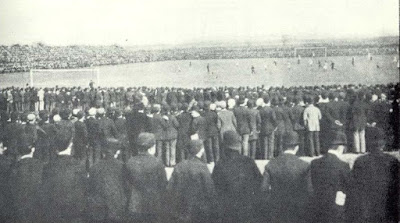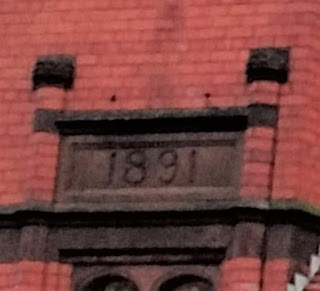While drinking a coffee in Fallowfield recently, I could not help but notice this façade of the old railway station directly across the road from where I was sitting.
I got to wondering what dramas might have unfolded there.
As the date carved into the brickwork indicates the station was opened in October, 1891.
It was in its first two decades of existence that the station was at its busiest.
Its importance began a slow decline after the arrival of the first tram-line to Wilbraham Road in the early years of the Edwardian era.
The busy station soon became a tempting target for criminals, before it had been opened a decade, it had been burgled twice on the nights of Tuesday 2nd July, 1895 and that of Sunday/ Monday 24th/25th October, 1897.On both occasions, although some damage was caused as the burglars ransacked the offices, only a few small items were taken from forced open boxes and packages in the parcel office. (1)
The Fallowfield Stadium was only a short walk away and consequently passenger numbers were often swelled by major sporting events being held there.
The largest of these was the 1893 F.A. Cup Final when Wolverhampton Wanderers beat Everton 1-0. The attendance that day was recorded as 45,000, more than double the grounds capacity, many of whom would have arrived by train from Liverpool and the Midlands.
 |
| F.A. Cup Final at Fallowfield - 25th March, 1893 |
The lesson was not completely learned, however, as in 1899 it was decided that it would stage the second replay of the cup semi-final between Liverpool and Sheffield United.
This proved to be disastrous, according to the Sheffield Daily Telegraph of the 28th May, 1899, with the game descending into a farce. A crowd of over 35,000 repeatedly encroached onto the playing area and after a number of prolonged stoppages the match was abandoned at half-time. (2)
Several important Rugby Football matches of both codes (League and Union) were somewhat more successfully staged at the Fallowfield Stadium. The last England v Scotland rugby international to be held outside London or Edinburgh took place there on the 13th March, 1897.
Two Rugby League Cup Finals were played on the ground in front of more manageable attendances of just over the ground’s capacity. In 1899 Oldham beat Hunslet 18 points to 9 and in 1900 Swinton defeated Salford 16-8.
The Manchester Courier and Lancashire General Advertiser the Tuesday after this later match carried an article chronicling the impact on the traffic through Fallowfield Station. It was reported that almost 3,000 additional passengers passed through the station and that during the scrambling to board trains after the match a number of carriage windows were broken. The reporter also made a point of commending Mr. C. R. Mapleston, the station-master, and his staff for a job well done.Charles Robert Mapleston was to feature in that same paper a little over 8 years later in more tragic circumstances. On the 3rd June, 1908 he committed suicide by cutting his own throat. He was found by his 19-years-old daughter, Lillian Gertrude, in the scullery of his home at 2, Ladybarn Road, Fallowfield, Manchester. An inquest on the 5th June returned a verdict of “suicide while insane”.
Mr. Mapleston was born in Lincoln, Lincolnshire in the September quarter of 1851. His birth parentage is a little unclear but he was reared by Charles Mapleston, a railway gateman, who married a widow, Mary Otter (née Brown), after Charles Robert’s birth, on Christmas Day, 1851 at the parish church of St. Peter at Gowts, Lincoln.
Charles Robert Mapleston married Matilda Ann Holmes, the daughter of the area’s registrar, Henry Holmes, at St. Martin’s Church, Lincoln on the 31st May, 1881. Shortly after their marriage the couple moved to a small village in the south of the county, Ripplingale, where their two children were born. Henry Holmes was born in the March quarter of 1884; his sister, Lillian Gertrude arrived on the 7th September, 1888.
The Fallowfield stadium was the home of the Manchester Athletics Club and also featured cycling events. The stations proximity to it meant that it was a convenient location to serve as both the start and finish points for races in both sports. When the expansion of the electric tram network there was a steady decline in passenger traffic on Manchester’s suburban railways; Fallowfield, however, remained an important station. With the opening of Manchester City’s new ground at Maine Road in 1923 Fallowfield Station had a new lease of life. Being the nearest railway station to the ground, passenger numbers using it were boosted by the huge crowds attending important fixtures there. This was particularly true when the home team were playing a Yorkshire side, especially one of the two Sheffield clubs. (3) The link to Sheffield and South Yorkshire generally was first rate; Fallowfield being built by the Manchester, Sheffield and Lincolnshire railway. In the 1920s and 30s, the L.N.E.R. ran special trains from Sheffield’s Victoria Station to Fallowfield for these fixtures. The half day return fare was 3/6d.
A number of accidents occurred in the vicinity of the station pre-World-War-One. On the 15th August, 1909, John James Kearney, a 47-year-old insurance clerk, of 102, Junction Street, Miles Platting, was struck by a car and suffered a head injury severe enough for him to be admitted to the Manchester Royal Infirmary (M.R.I.). Thomas Whittam Collingwood, of 17, Church Street, Hooley Hill, Audenshaw, Lancashire was following in his father’s footsteps, working in the dangerous occupation of railway platelayer when he was struck by a train close to Fallowfield Station on the 13th July,1913 . He was taken to the M.R.I. where although his condition the next day was said to be critical, he fortunately made a full recovery and lived to be in his 82nd year when he died on the 4th June, 1975. Just over a year later on the 16th July, 1914 James Salkeld, a violinist with the Palace orchestra and a father of seven children, of 36, Coupland Street, Hulme, Manchester was knocked of his bicycle by a tram and taken to the M.R.I. , where he was treated for a crushed foot.Finally, I have noticed the entrance to this station shows a similarity to those at Trafford Bar and Knott Mill as this photograph of the station in 1905 (and the other two) reveals.
Pictures: - Fallowfield station December 2021, courtesy of Andrea Martinez. Crowd at 1893 F. A. Cup Final by unknown photographer, in public domain. Fallowfield Station (1905) m 63465 and Knott Mill/Deansgate Station by T.A. Fletcher (18/8/1970) m 62884 courtesy of Manchester Libraries, Archives, and Information, Manchester City Council; http://manchester.gov.uk/index.php?session=pass Old Trafford when it was a British Rail station, 1988. By Peter Whatley, CC BY-SA 2.0, https://commons.wikimedia.org/w/index.php?curid=7291941
Notes: -
1) The newspaper reporting of the first of these break-ins is interesting. The Bolton Evening News reported that one of items the thieves departed with after rifling through the parcels was a dress, addressed to a lady in Rusholme. It was stated that its value was in the region of £8 which made it an outstandingly valuable garment; £1,075 at today’s prices. The Manchester Evening News, on the other hand, chose to feature the fact that they had left with a set of keys and just one of the station-master's two hats!
2) The first incursion by the spectators came after just a quarter of an hour with Liverpool, who scored in the 6th minute, leading 1-0. After a five-minute delay, play was resumed only for the players to be forced to return to the dressing rooms 10-minutes later. It became evident that the tie would likely have to be abandoned. A second resumption was made after a delay of 50-minutes including a false start when the Liverpool team returned to the field but not Sheffield United’s. Eventually the match reached half-time when, with the score still 1-0, it was finally abandoned.
The game was re-arranged to be played at Derby County’s Baseball Ground. Sheffield United won this match 1-0 and went on to win the Cup by beating Derby County, 4-1 at Crystal Palace, London.
3) The largest attendances were normally reserved for cup-ties.
In April, 1928, Maine Road was chosen to host the second replay of the F. A. Cup Semi-Final between Huddersfield Town and Sheffield United. Despite the match being played on a Monday afternoon the attendance was recorded as 69,360. Six years later, in the afternoon of Wednesday 21st February, 1934 only a slightly smaller crowd of 68,614 witnessed Manchester City defeat the other Sheffield club, Sheffield Wednesday, 2-0 in a replayed F.A. Cup 5th round tie on their way to winning the trophy that year.
Acknowledgements: The British Newspaper Archive, census and other records on Find My Past. Additional facts and confirmations from Wikipedia and the ”City Til I Die” website of Manchester City Supporters. Lastly, with thanks to the late Linda Rigby I made good use of “Looking Back at Rusholme and Fallowfield” 1984 by Peter Helm and Gay Sussex.





No comments:
Post a Comment